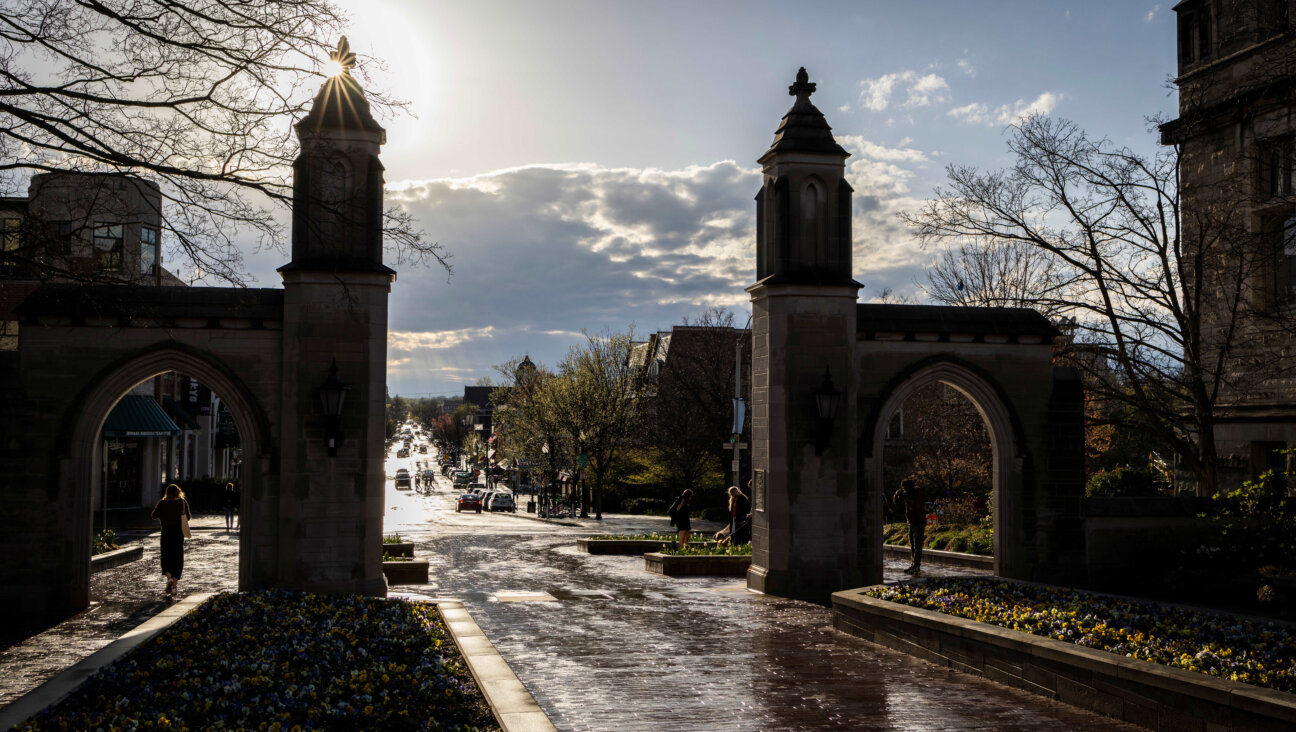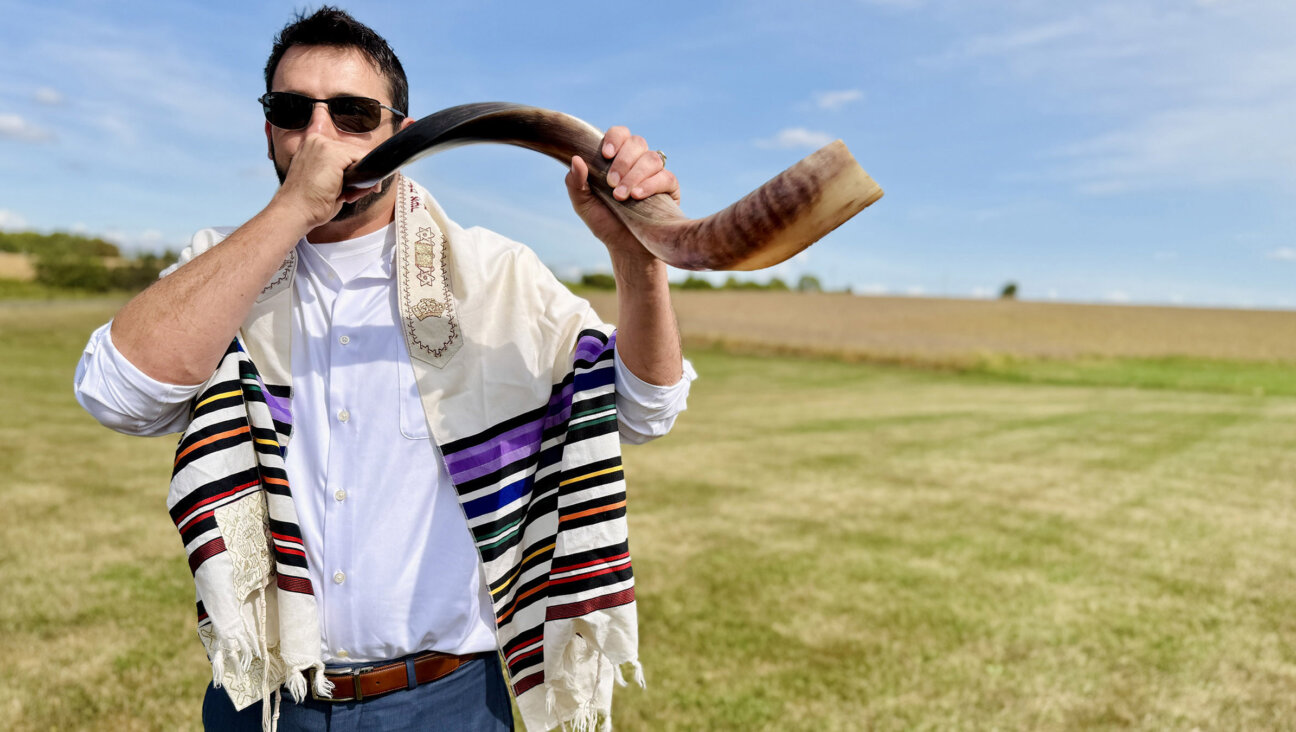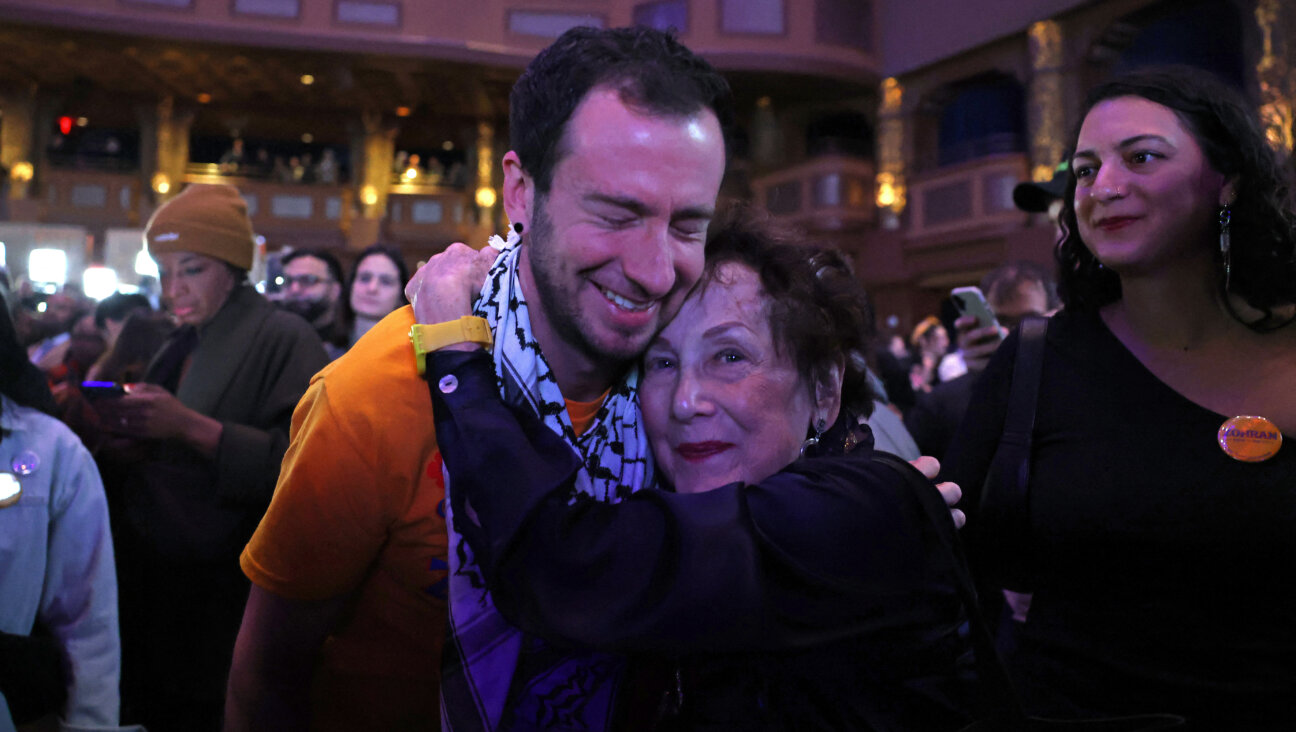Close to crumbling, the tomb of an ancient prophet is saved in Kurdish Iraq

Graphic by Angelie Zaslavsky
For nearly 30 centuries the tomb of the prophet Nahum was an important pilgrimage site for Jews in what is today Kurdish Iraq.
But after the founding of Israel in 1948, all its Jewish caretakers began leaving the region, and in more recent years, the Islamic State embarked on its campaign to destroy holy sites across Iraq, coming within five miles of Nahum’s tomb before it was turned back by airstrikes. By 2016, the tomb — a sprawling complex that includes the remnants of a synagogue and study rooms — was nearing complete collapse.
“To me, it looked like it was beyond rescue. It was in such terrible condition,” said Cheryl Benard, an American whose non-profit organized the effort to reconstruct the tomb. “We really only had a couple of months to do something about this site, because it likely wouldn’t last another winter.”

The Exterior of Nahum’s Tomb. Courtesy of ARCH International
Those involved with the rescue of the Tomb of Nahum call it a remarkable international effort, a collaboration of both Jews and non-Jews to reconstruct the history of the shrine, and to restore it in keeping with Jewish tradition.
It happened, Benard said, because people care about preserving their history, something that became clear to her during her 20 years as a political scientist working in war zones,
“I was struck by how important cultural heritage sites and monuments were to people, even when they had lots of other things to worry about,” Benard said. “These monuments and sites represent hope, identity, pride or all of those things.”
The Burden of Nineveh
Nahum the Alqoshite — so called because he’s from the town of Alqosh — is believed to have lived in the 7th century BCE. One of the Hebrew bible’s 12 minor prophets, Nahum is also known as “The Burden of Nineveh” because he prophesied the destruction of the city, then capital of the great Assyrian Empire, and likely one of the largest cities in the world in its day.
The ruins of Nineveh have long since been rebuilt into what is today the Iraqi city of Mosul, about an hour’s drive south of Alqosh. Since ancient times, dozens of empires and factions, from the Sassanid Persians to the Islamic State, have come and gone through the region.

The Village of Alqosh. By Kathryn Costello
Its residents still identify as ethnic Assyrians — using the name of the very empire Nahum prophesied against — and continue to speak a dialect of Aramaic, the lingua franca of the ancient Near East.
It’s an outlier in a region largely divided between Kurds, Arabs and Turkmen peoples.
Many villages in Northern Iraq, such as Zakho, had longstanding Jewish communities at the turn of the 20th century.
“Jews were an integral part of the fabric of that region for thousands of years,” said Adam Tiffen, ARCH’s treasurer, who is Jewish. “In fact our faith comes from that region, Abraham was from Ur, the Talmud was written in Babylon.”

Christian murals in the village of Alqosh, where Aramaic is still the main spoken language. By Kathryn Costello
Nonetheless, the village would fill up with Jews every spring, as it became a pilgrimage site for the harvest festival of Shavuot.
An entire complex grew up around the tomb for the Jewish pilgrims who would spend the holiday there. A smaller adjacent tomb is also traditionally believed to be the final resting place of Nahum’s sister, Sara. The current structure dates as far back as the 12th century AD — though that’s almost 2,000 years after the purported lifetime of the prophet.
Those pilgrimages came to an end in 1948 as, like elsewhere in the Middle East, Iraq was depopulated of its Jews following the establishment of the state of Israel.
However, such was local Jewry’s reverence for their prophet, that upon their arrival in Israel a community of Kurdish Jews settled in the town of Elkosh, which is in an area others had pointed to as the possible birthplace of Nahum.
When the last of Kurdistan’s Jews left, Nahum’s tomb was left in the care of a local Christian.
As much a part of the Christian bible as the Hebrew, the tomb inspired similar reverence among Christians. But the agricultural town of Alqosh, with less than 5,000 residents, had little ability to maintain it.
At the brink of destruction
The sorry state of the tomb first came to the attention of Tiffen and Benard, ARCH’s founder, in 2016, when Iraq was at the height of its war with the Islamic State, or ISIS. Benard was in the area working with another NGO, bringing medical supplies to the Kurdish peshmerga forces which were battling ISIS in Alqosh’s neighboring villages.
“It was mentioned to us that in Alqosh there was this shrine, the only prophet that hadn’t been blown up by ISIS, because they haven’t gotten to Alqosh yet,” said Benard, who grew up in post World War II Germany, where she said she witnessed first hand how communities banded together to reconstruct heritage sites damaged by war.
ISIS already had a history of dynamiting historic and holy sites, such as the tomb of the Prophet Jonah in Mosul. It based this destruction in its strictly Salafist interpretation Islam, which holds that even physical shrines to Islamic holy figures, let alone those associated with other religions, could lead the faithful to “shirk” or polytheism.
Though ISIS came perilously close to Alqosh before military maneuvers turned its fighters back, the Tomb of Nahum was still far from safe.
The elements were proving just as dangerous.
From Jerusalem to Alqosh
To save Nahum’s tomb, ARCH knew they needed experts who were both knowledgeable about historical construction and traditional synagogue architecture.
They found Yaacov Shaffer and Meir Ronen, two Israeli engineers who specialize in historic conservation, have worked with synagogues before and could diagnose the site’s weaknesses and advise on a plan to save it.
But sending them to Iraq on their Israeli passports raised many security questions.
It “would have been easier to bring engineers from any place other than Israel,” Tiffen said. “But we wanted to start out the project with sensitivity and work with people who had some understanding of and experience working on Jewish cultural heritage sites.”
After getting the go ahead from Israel’s interior ministry the pair set off from Jerusalem, transiting through Istanbul to Erbil, the capital of Iraq’s Kurdish regional government, where they soon learned that many things in the Kurdistan region would be different than they expected.
“I appreciate them so much for their leap of faith, really, because they didn’t know what they were getting into and what the situation would be like in Iraq, and in Northern Iraq,” Benard recalled. “They just came, they trusted us, and within a couple of hours, they had relaxed, were feeling fine and already they were telling everybody who asked them that they were from Israel, and getting really nice reactions to that.”
Shaffer and Ronen remember that one of the biggest surprises was the size of the site — not just a single room for prayer but several rooms and study halls.
“Everyone had said to us ‘synagogue’ or ‘tomb’ but it’s a really big site, not just a small monument. It’s very labyrinthine,” Shaffer said.

Stabilization efforts on the interior of the tomb while the restoration was completed. Courtesy of Kathryn Costello
“In Israel, we don’t really find the same materials. Okay, the stone is stone, but all the mortar and refilling between the stones is not the same,” Shaffer explained.
As they studied the complex the engineers also took note of what had already collapsed compared to what remained standing.
“We also learn from the failures of the building,” Shaffer said.
A persistent Jewish character
Shaffer and Ronen said the trip was important to them as engineers who specialize in historic Jewish architecture, but also as Jews.
“Both of us learned in high school about the Prophet Nahum,” Ronen said. “It was very impressive to be there. It’s such an important Jewish tomb.”
Many claim that three other Hebrew prophets — Jonah, Daniel And Ezekiel — are also buried in Iraq (though others point to sites from Israel to Iran and as far as Uzbekistan and Morocco, as the final resting place of some of the same prophets.)

Hebrew inscriptions are present all throughout the tomb. Courtesy of ARCH International
“It’s very important for us to save heritage,” Ronen said. “Here, we saved our own, but also for others as well. It doesn’t matter the religion, it is important to save. We will work on churches and other monuments too.”
Ronen saw that attitude reciprocated in Alqosh in the Christian caretaker of the tomb.
“Who keeps this shrine and holds the key for all this time? A citizen of this city for forty something years cleans the tomb with his family. They’re not Jewish, but it shows that to respect another religion or culture, you don’t need to be from the same religion,” Ronen said.
Other elders in Alqosh told the two how they remembered celebrating holidays together with the Jewish community when they were children.
“It’s really amazing, in that land with all its war and armies, one time it was a beautiful land with a beautiful relationship between the Jews and other local citizens,” Ronen added.
After Shaffer and Ronen’s preliminary analysis of the site, further assessments and the restoration work itself was completed by GemaArt, a Prague-based firm which had previously worked on nearly a dozen synagogues and Jewish sites in the Czech Republic.
‘Blackmailing’ the prophet
ARCH’s team also made several trips to Israel to meet with Sephardic rabbis and Iraqi Jewish leaders to make sure their work on the tomb would respect local tradition.
Tiffen even met with Israel’s former Sephardic chief rabbi, Shlomo Amar, to discuss the project.
“He blessed the plan, with the only prohibition that we not disturb the grave itself, which we didn’t,” Tiffen recalled.
And Israel’s Kurdish Jewish community helped. Though the ARCH team had a good understanding of the Tomb of Nahum’s architecture, they didn’t know much about what it had looked like on the inside.
By the time they got to it, the site had been picked clean of almost everything moveable, from ritual objects to light fixtures. While it’s possible that some of it was taken by Kurdish Jews when they fled Iraq, it’s likely that most objects were looted by antiquities traffickers who have ravaged Iraq of its cultural heritage for decades.
Stories and memories shared by Israeli Kurdish Jews added pieces to the puzzle. “We were hoping that they would have information and photos about what the shrine looked like,” Benard said. “Also, we wanted to learn more about the traditions, because ironically, you know, our initial information about the traditions of the shrine all came from, like, Christian onlookers.”
Benard and Tiffen travelled to Jerusalem’s Iraqi market, a part of the Mahane Yehuda Bazaar, in the hopes of finding someone who remembered the old days at the tomb.
“We talked our way around the various stalls and got connected with some elders who were from Zakho or other places nearby and started filling in the details a little bit,” Benard said.
They found a few people who were at best children the last time they saw the tomb, but the pair gleaned some insightful anecdotes.

Hebrew inscriptions over the entrance to one of the complex’s rooms. Courtesy of ARCH International
One elderly rabbi recalled how his mother once even tried to blackmail the prophet.
“His brother, who was six or so years old, had not spoken yet. The family went to the tomb trying to seek the prophets to help,” Benard said. “Their mother told the prophets that they were going to stay in the shrine. They were moving in, and they were going to stay there until their child spoke.”
According to the rabbi, her plan worked: his brother spoke and later became a successful dentist.
A future for the tomb
Benard hopes that when the project is complete it will include an exhibition at the site to relate such stories.
“We would love to have a sort of an installation where people can listen to oral histories of Jewish people who are now in Israel, speaking about what they remember about their time in northern Iraq,” she said.
While in Jerusalem, her team was also impressed by the interest of young Kurdish Jews to return to the region.
“It was really astonishing to me, how the community remained connected to a place in which most of them have never been, and those that had been there hadn’t been there for 50-plus years,” Tiffen said.
“They really would like to go back and see the place that their parents or their grandparents talked about,” Benard added.
While larger Iraq-Israel relations still range from non-existent to fraught, she thinks it may yet be a real possibility, at least in the semi-independent Kurdistan region, which has historically had warmer relations with Israel.
“The Kurdish authorities have no problem with that,” Benard said “But I think everybody needs to feel a lot more comfortable with the situation and the security aspects of it before that kind of tourism is likely to occur.”
In the interim, would-be pilgrims can explore the tomb virtually on ARCH’s website.

















